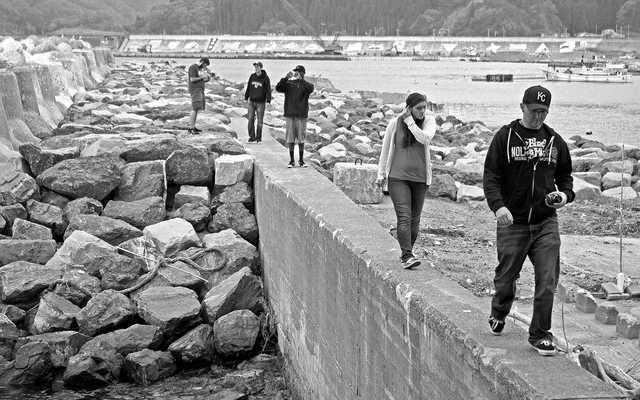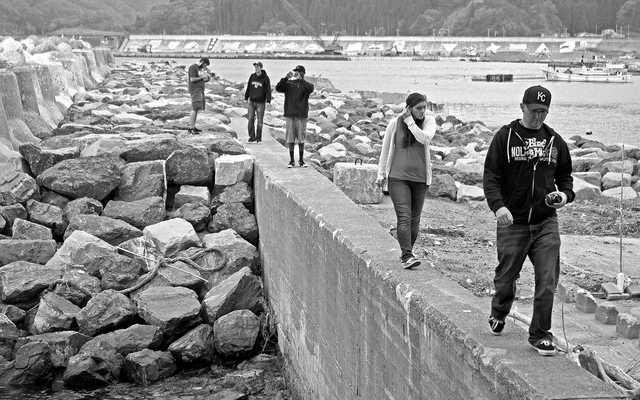PLATTEVILLE — Five UW–Platteville students embarked on a 1,000-mile rail journey through Japan this summer with Dr. H. Todd Stradford, associate professor in the UW–Platteville Geography Program.
In their travels, the group visited large urban centers and remote fishing villages, saw everything from volcanoes, caves and waterfalls to temples, statues and shrines, sampled all types of foods, and explored outdoor markets and museums.
In their visit to the Sanriku Coast in Iwate Prefecture, students also saw firsthand the ongoing cleanup and rebuilding efforts following the earthquake and resulting tsunami that left destruction up and down Japan’s eastern coast in March 2011.
Although last year’s trip was canceled for students, Stradford, who studied and worked in Japan for many years and has led the UW–Platteville field course there since 1998, made the trek on his own to check on friends and see the damage for himself. In comparing what he saw then to what he and students saw this summer, Stradford said a lot has been done, but there is still a lot left to do.
“We explored the port area of Miyako City and Taro, which lie just north of the 2011 earthquake’s epicenter, to see what had changed in 15 months,” said Stradford. “A boat repair business was up and running in Miyako harbor, and there were a lot of small fishing boats. The harbor is not as large as the original, but it’s enough to get them out working so they can make an income.”
Stradford said debris in the port of Taro, where huge concrete blocks had washed throughout and blocked access, had been removed and a new breakwater wall, replacing the one that had washed away, sits at the harbor entrance. Fishing boats present in the harbor, as well as a few new equipment storage sheds, show a slow but steady recovery.
“The huge debris pile made up of the old town was reduced to about a third of its size as compared to last year,” he said. “All the recyclables, such as appliances and cars, had been taken away.”
Work is also being done to increase Taro’s 2.1 kilometer-long tsunami wall from 10 meters to 14.5 meters high. “It wouldn’t have stopped the 2011 tsunami, but it would have stopped enough of the water to limit the damage,” said Stradford. “Fudai-mura, a town up the coast, had a 15-meter-high wall and gate that survived even though it was topped.”
Before leaving Taro, students spent time with the high school senior class practicing their language skills, something the school’s principal told Stradford he very much appreciated. “He thought his students would be too shy to try to speak English, but with the college-aged students, they opened up and everybody had a good hour or so,” he said.
Stradford said enrollment at THS was down almost 50 percent because so many families had to relocate. Further down the coast was a similar situation. Repairs had begun in almost all of the coastal communities, but many people were still living in temporary housing. Several roadways also remained in disrepair.
Over the course of the trip, students also took in ancient transportation routes like the Nakasendo in Matsumoto and the Tokaido, Japan’s most important historical transportation route and now the most highly traveled. They also stopped in Narai, an old post town featuring a long corridor of historically-protected homes from the Edo period, rode a cable car to the top of Mount Misen on the island of Miyajima and visited the Hiroshima Peace Memorial Museum.
Each annual trip to Japan is a little bit different from the year before because Stradford builds in flexibility for changing weather conditions and also to allow additional time at sites that students seem particularly interested in. Students also have most weekends free to do journal work and see sites of their choosing in nearby areas.
The application deadline for next summer’s field course, which does not require prior Japanese language study, is Jan. 25. Two different options are available: a one- to three-credit three-week stay that includes the rail journey between the islands of Hokkaido in the north and Kyushu in the south, and a six-credit six-week option that features a home stay with local families.
Students who elect the one- to three-credit course must complete a detailed geographic journal, noting and photographing the differences in landscape, economies and communities along the rail journey. The six-credit course requires that students also select a research topic and do field study in the region.





